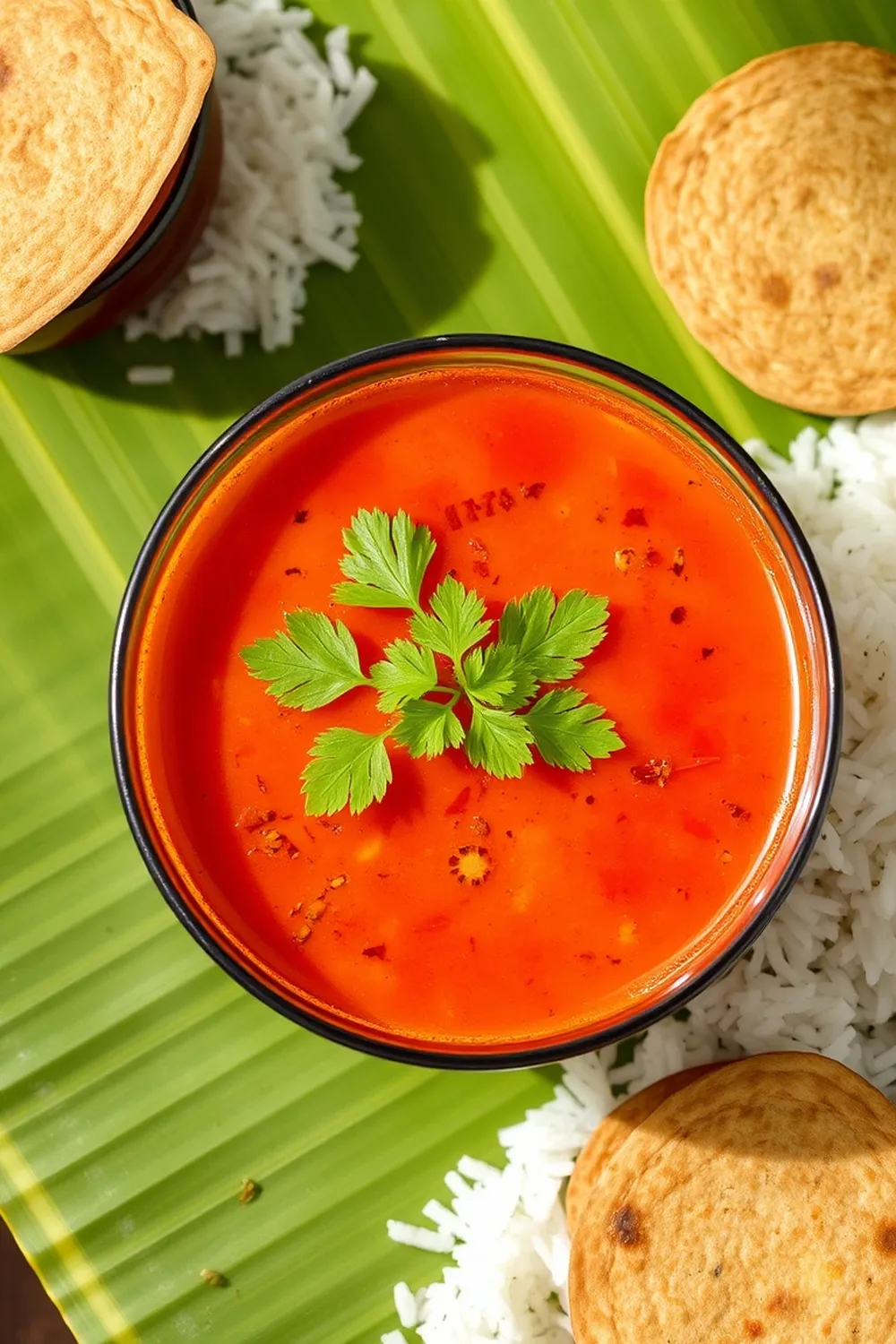- Cook chopped tomatoes, salt, red chili powder, turmeric, garlic, and water in a pot until the tomatoes soften.
- Cool the mixture, mash the tomatoes, and strain the pulp.
- Combine tomato pulp, tamarind extract, water, spices, and sugar. Boil the mixture.
- Heat oil in a pan for tempering. Add mustard seeds, cumin seeds, garlic, onions, red chilies, and curry leaves. Sauté until fragrant.
- Pour the tempering into the boiled rasam. Garnish with coriander leaves.
- Serve hot with steamed rice, papad, and vegetable fries.
- Calories:200 kcal25%
- Energy:836 kJ22%
- Protein:4 g28%
- Carbohydrates:25 mg40%
- Sugar:8 mg8%
- Salt:600 g25%
- Fat:8 g20%
Last Updated on 2 months by Neha Deshmukh
Authentic Tomato Rasam Recipe – South Indian Comfort Food
Hey everyone! If you’re craving a warm, comforting bowl of goodness, you’ve come to the right place. Today, I’m sharing my family’s treasured Tomato Rasam recipe. It’s a South Indian staple, and honestly, it’s my go-to when I’m feeling a little under the weather or just need a hug in a bowl. I first made this on my own when I was a student, and it instantly transported me back to my grandmother’s kitchen. Let’s get cooking!
Why You’ll Love This Recipe
This Tomato Rasam isn’t just delicious; it’s incredibly versatile. It’s light yet flavorful, perfect for a quick lunch or a comforting dinner. Plus, it’s packed with health benefits (more on that later!). It’s a fantastic way to use up ripe tomatoes and is ready in under an hour. Trust me, once you try this, it’ll become a regular in your rotation.
Ingredients
Here’s what you’ll need to make this magic happen:
- 5-6 tomatoes
- To taste salt
- 1 teaspoon red chilli powder
- ½ teaspoon turmeric powder
- 2-3 garlic cloves
- 1 lemon-sized tamarind pulp (about 100g)
- 1 teaspoon roasted coriander seeds powder
- 1 teaspoon roasted cumin seeds powder
- 1 teaspoon black pepper corn powder
- A pinch of sugar
- 1 tablespoon oil
- 1 teaspoon mustard seeds
- 1 teaspoon cumin seeds
- 2-3 garlic cloves
- 1 small onion
- 3-4 dried red chillies
- 5-6 curry leaves
- 2 teaspoon chopped coriander leaves
Ingredient Notes
Let’s talk ingredients! A few things make this Rasam truly special.
- Tamarind: Don’t skip the tamarind! It’s the key to that signature tangy flavor. You can find tamarind pulp at most Indian grocery stores. If using tamarind block, soak it in warm water and extract the pulp.
- Red Chillies: I prefer using Byadagi chillies for a vibrant color and mild heat. But feel free to use any dried red chillies you like – Guntur chillies will give you a much spicier kick!
- Roasted Spices: Roasting the coriander and cumin seeds before grinding them elevates the flavor profile immensely. It adds a lovely warmth and depth. Just a quick dry roast in a pan until fragrant is all it takes.
Step-By-Step Instructions
Alright, let’s get down to business!
- First, in a pot, combine the chopped tomatoes, salt, red chilli powder, turmeric powder, and 2-3 garlic cloves. Add about 2 cups (480ml) of water. Bring this to a boil and let it simmer until the tomatoes are completely softened – about 15-20 minutes.
- Once cooled slightly, gently mash the tomatoes. Then, strain the mixture through a sieve to get a smooth tomato pulp. Discard the skin and seeds.
- Now, in the same pot, combine the strained tomato pulp, tamarind extract, another 1-2 cups (240-480ml) of water, roasted coriander powder, roasted cumin powder, black pepper powder, and a tiny pinch of sugar. Bring this to a boil and let it simmer for another 10-15 minutes. This allows all the flavors to meld together beautifully.
- While the Rasam is simmering, let’s prepare the tempering. Heat the oil in a small pan. Add the mustard seeds. Once they splutter, add the cumin seeds, 2-3 garlic cloves (crushed), a small chopped onion, the dried red chillies (broken into pieces), and the curry leaves. Sauté until the onions are golden brown and fragrant.
- Carefully pour the tempering into the boiling Rasam. Give it a good stir.
- Finally, garnish with fresh chopped coriander leaves. And that’s it!
Expert Tips
- Adjusting Consistency: If you prefer a thinner Rasam, add more water. For a thicker consistency, simmer for a longer time.
- Tomato Quality: Ripe, juicy tomatoes are best! They’ll give you the sweetest and most flavorful Rasam.
- Don’t Overcook: Be careful not to overcook the Rasam after adding the tamarind, as it can become bitter.
Variations
Rasam is super adaptable! Here are a few ways to switch things up:
- Vegan Adaptation: This recipe is naturally vegan! Just ensure your tamarind pulp doesn’t have any added ingredients.
- Spice Level Adjustment:
- Mild: Reduce the red chilli powder to ½ teaspoon or omit it altogether.
- Medium: Stick to the 1 teaspoon of red chilli powder.
- Hot: Add an extra ½ teaspoon of red chilli powder or use hotter chillies.
- Regional Variations:
- Tamil Nadu: Often includes a small piece of jaggery for a touch of sweetness.
- Kerala: Sometimes includes a pinch of asafoetida (hing) in the tempering.
- Andhra: Known for its spicier Rasam, often using more red chillies.
- Festival Adaptations: During Pongal or Onam, I sometimes add a handful of lentils (toor dal) to the Rasam for extra richness.
Serving Suggestions
Rasam is best enjoyed hot! It’s traditionally served with:
- Steamed rice
- Papad
- Vegetable fries (like potato fry or brinjal fry)
- A dollop of ghee (optional, but highly recommended!)
Storage Instructions
Leftover Rasam can be stored in an airtight container in the refrigerator for up to 3 days. It actually tastes even better the next day as the flavors deepen! You can also freeze it for longer storage.
FAQs
What is Rasam and its health benefits?
Rasam is a thin, watery soup originating from South India. It’s known for its digestive properties and is often considered a remedy for colds and coughs. It’s also rich in Vitamin C and antioxidants.
What is the best type of tomato to use for Rasam?
Roma or plum tomatoes work really well because they’re less watery. But honestly, any ripe tomato will do!
Can I make Rasam paste ahead of time?
Absolutely! You can make the tomato pulp and tamarind mixture ahead of time and store it in the fridge for a day or two. Just add the tempering when you’re ready to serve.
How do I adjust the sourness of the Rasam?
If it’s too sour, add a pinch of sugar. If it’s not sour enough, add a little more tamarind extract.
What can I serve with Rasam besides rice?
You can enjoy Rasam with idli, dosa, or even as a soup on its own!
Enjoy this comforting bowl of South Indian goodness! Let me know in the comments how it turns out for you. Happy cooking!








